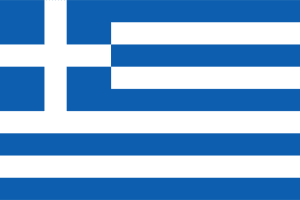
| Colors | HEX Code | RGB | CMYK |
|---|---|---|---|
| Blue | #0D5EAF | 13, 94, 175 | 93, 46, 0, 31 |
| White | #FFFFFF | 255, 255, 255 | 0, 0, 0, 0 |
The Greek Flag is made of 9 blue horizontal stripes. There are 5 blue stripes and 4 white stripes on the flag, with a white cross on a blue background in the canton.
Meaning of the Greek Flag
Blue and white are the national colors of Greece. The blue color represents the purity of the Greek struggle for independence. The blue symbolizes the sky and the seas. The cross represents the Christian religion. The 9 stripes represent the nine syllables of the motto “Freedom or Death.” which represents the motto of the Greeks in their struggle for independence
History of the Greek Flag
The flag of Greece is 200 years old. Although it had different versions, the white cross against a blue field has always been present. Greece was part of the Ottoman Empire. In the 19th century, it started to aspire for independence and freedom. Flags of different versions and colors were used by the Greeks during their revolt. The national revolution led Greece to independence in the 1820s. The blue and white colors which represented the faith and loyalty to the Orthodox Church were adopted as the colors of the national flag in 1822. The flag was a white field with a blue cross that extended to the edges of the flag. In 1863, after George I, prince of Denmark, ascended to the Greek throne, a crown was placed at the center of the cross for all flags. The crown was removed from the flag, only to be added later in 1935. The crown was removed again when Greece became a republic. The shades of blue have changed over time. Later in the 1970s, the light blue became dark blue. In 1978, the former sea flag with the nine stripes was adopted, as the national flag, and continues to be official today.